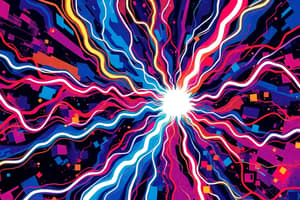Podcast
Questions and Answers
ما هو مصدر創ء مجال مغناطيسي؟
ما هو مصدر創ء مجال مغناطيسي؟
- بتفاعل ميكانيكي بين المغناطيسات
- بتفاعل حراري بين المغناطيسات
- بحركة الجسيمات المشحونة مثل الإلكترونات (correct)
- بتفاعل كيميائي بين المغناطيسات
ما هو方向 مجال مغناطيسي؟
ما هو方向 مجال مغناطيسي؟
- يتم تحديده باتجاه قوة التي تؤثر على شحنة تجريبية (correct)
- يتم تحديده باتجاه حركة الشحنة
- يتم تحديده باتجاه القوة المغناطيسية
- يتم تحديده باتجاه المجال الكهربي
ما هو قانون كيرشوف围ي الناتج عن تيارات كهربائية؟
ما هو قانون كيرشوف围ي الناتج عن تيارات كهربائية؟
- قانون كيرشوف للتسارع: مجموع القوة الكهربائية يساوي صفر
- قانون كيرشوف للتسارع: مجموع القوة المغناطيسية يساوي صفر
- قانون كيرشوف للجهد: مجموع فرق الجهد حول أي دائرة مغلقة يساوي صفر (correct)
- قانون كيرشوف للشحنة: مجموع الشحنة الكهربائية يساوي صفر
ما هوlaw لتحديد قوة المغناطيسي على جسيم مشحون متحرك؟
ما هوlaw لتحديد قوة المغناطيسي على جسيم مشحون متحرك؟
ما هو unidades لقياس شدة المجال الكهربي؟
ما هو unidades لقياس شدة المجال الكهربي؟
ما هو محتويات الدائرة الكهربائية؟
ما هو محتويات الدائرة الكهربائية؟
ما هو النوع من المغناطيسية الذي يظهر في المواد التي تنجذب بشدة إلى المغناطيس؟
ما هو النوع من المغناطيسية الذي يظهر في المواد التي تنجذب بشدة إلى المغناطيس؟
ما هو القانون الذي ي describe العلاقة بين قوة الإمف.induced في موصل والمتغير المجال المغناطيسي؟
ما هو القانون الذي ي describe العلاقة بين قوة الإمف.induced في موصل والمتغير المجال المغناطيسي؟
ما هو الجهاز الذي يستخدم لزيادة أو نقصان جهد التيار المتردد؟
ما هو الجهاز الذي يستخدم لزيادة أو نقصان جهد التيار المتردد؟
ما هو المصطلح الذي يصف الإنتاج της التيار الكهربائي في موصل عندما يتم وضعه في مجال مغناطيسي متغير؟
ما هو المصطلح الذي يصف الإنتاج της التيار الكهربائي في موصل عندما يتم وضعه في مجال مغناطيسي متغير؟
ما هو النوع من المواد الذي يظهر مغناطيسية-diamagnetism؟
ما هو النوع من المواد الذي يظهر مغناطيسية-diamagnetism؟
ما هو التطبيق الرئيسي ل قانون فاراداي للاستقراء؟
ما هو التطبيق الرئيسي ل قانون فاراداي للاستقراء؟
Flashcards are hidden until you start studying
Study Notes
Magnetism
Magnetic Fields
- A magnetic field is a region around a magnet or electrical current where the magnetic force can be detected
- Magnetic fields are created by the motion of charged particles, such as electrons
- The direction of a magnetic field is defined by the direction of the force it would exert on a test charge
Magnetic Poles
- Every magnet has two poles, the north pole and the south pole
- Like poles (north-north or south-south) repel each other, while opposite poles (north-south) attract each other
- The strength of a magnet is determined by the distance between its poles and the material it is made of
Magnetic Forces
- The force exerted by a magnetic field on a moving charge is given by the Lorentz force equation: F = qv x B
- The force exerted by a magnetic field on a current-carrying wire is given by the equation: F = IL x B
- Magnetic forces can be attractive or repulsive, depending on the direction of the magnetic field and the moving charge or current
Electricity
Electric Charge
- Electric charge is a fundamental property of matter that can be positive or negative
- Positive charge is associated with protons, while negative charge is associated with electrons
- Electric charge is quantized, meaning it comes in discrete amounts (e.g., 1 electron has a charge of -1.6 x 10^-19 C)
Electric Field
- An electric field is a region around a charged object where the electric force can be detected
- The electric field is a vector field that points away from positive charges and towards negative charges
- The strength of an electric field is measured in units of volts per meter (V/m)
Electric Potential
- Electric potential, or voltage, is the potential energy per unit charge at a given point in an electric field
- The electric potential difference between two points is measured in volts (V)
- Electric potential is a scalar quantity, meaning it has no direction
Electric Circuits
- An electric circuit is a path through which electric current flows
- Electric circuits consist of sources of electromotive force (EMF), resistors, capacitors, and inductors
- Kirchhoff's laws are used to analyze and design electric circuits:
- Kirchhoff's Voltage Law (KVL): The sum of the voltage changes around any closed loop is zero
- Kirchhoff's Current Law (KCL): The sum of the currents entering a node is equal to the sum of the currents leaving a node
Studying That Suits You
Use AI to generate personalized quizzes and flashcards to suit your learning preferences.




